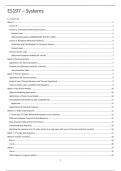Summary
ES197: Systems Modelling, Simulation, and Computation Summary Notes
- Course
- Institution
These meticulously crafted summary notes for the course ES197: Systems Modelling, Simulation, and Computation offer invaluable assistance to engineering students at the University of Warwick, whether you're working towards a Bachelor's or Master's degree. These notes provide a clear and concise ove...
[Show more]



